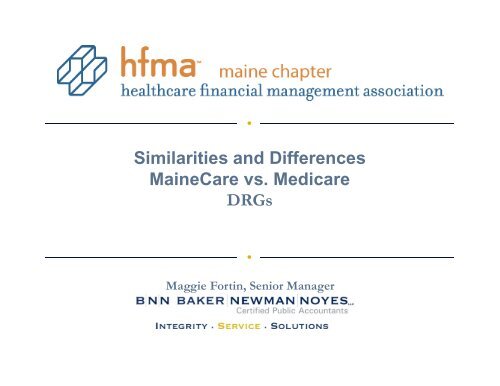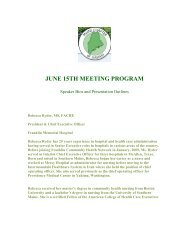Similarities and Differences MaineCare vs. Medicare DRGs
Similarities and Differences MaineCare vs. Medicare DRGs
Similarities and Differences MaineCare vs. Medicare DRGs
You also want an ePaper? Increase the reach of your titles
YUMPU automatically turns print PDFs into web optimized ePapers that Google loves.
•<br />
<strong>Similarities</strong> <strong>and</strong> <strong>Differences</strong><br />
<strong>MaineCare</strong> <strong>vs</strong>. <strong>Medicare</strong><br />
<strong>DRGs</strong><br />
•<br />
Maggie Fortin, Senior Manager
• What is an Inpatient<br />
<strong>MaineCare</strong><br />
•<br />
– a patient who has been admitted to the hospital<br />
<strong>and</strong> is receiving room, board <strong>and</strong> professional<br />
services in the hospital on a continuous twentyfour<br />
(24) hour-a-day basis<br />
•<br />
1
• Effective 7/1/2011<br />
Effective date<br />
•<br />
– The Department reimburses acute care (noncritical<br />
access hospitals) for inpatient services<br />
using a Diagnostic Related Group (DRG) billing<br />
methodology similar to that used by <strong>Medicare</strong><br />
•<br />
2
DRG Base<br />
•<br />
• <strong>MaineCare</strong>’s DRG payment methodology<br />
includes 3 components<br />
– a statewide direct care rate<br />
• DRG base case mix specific; not cost settled<br />
• Unadjusted $4177.00<br />
– a hospital specific estimated capital expense<br />
• cost settled<br />
– a medical education rate<br />
• cost settled<br />
•<br />
3
Fundamentals<br />
•<br />
• Assuming <strong>MaineCare</strong> has adopted the same<br />
policies used by <strong>Medicare</strong><br />
– The basis for payment is the classification system<br />
referred to as MS-<strong>DRGs</strong><br />
– The MS-DRG (<strong>Medicare</strong> Severity) is a payment<br />
classification system which provides a means of<br />
relating types of patients a hospital treats (i.e., its<br />
case mix) to the cost incurred by the hospital<br />
•<br />
4
Fundamentals<br />
•<br />
• To determine the appropriate MS-DRG<br />
classification, the billing system must read the<br />
age, gender, discharge status, principal<br />
diagnosis, secondary diagnoses <strong>and</strong><br />
procedures performed <strong>and</strong> reported on the<br />
claim.<br />
•<br />
5
Fundamentals<br />
•<br />
• Hospitals report detailed information on the<br />
claim:<br />
– Principal diagnosis is a key indicator<br />
• Defined as the condition established after study to be<br />
chiefly responsible for the admission<br />
– Secondary diagnoses support complicating<br />
factors<br />
• Defined as a condition(s) that coexisted or develop(s)<br />
<strong>and</strong> was managed medically during the course of<br />
treatment<br />
•<br />
6
DRG Relative Weight Calculation<br />
•<br />
• The relative weighting factor for the <strong>DRGs</strong> was assigned by the<br />
Department to represent the time <strong>and</strong> resources associated with<br />
providing services for that diagnosis group.<br />
– The Department calculates preliminary weights for each DRG, <strong>and</strong> then<br />
normalizes each weight to ensure that the statewide case mix index for<br />
applicable claims equals 1.0<br />
– The Department calculates relative weights using claims from critical access<br />
hospitals, non-critical access acute care hospitals <strong>and</strong> hospitals reclassified<br />
to a different <strong>Medicare</strong> geographic area<br />
• The weights do not include data from rehabilitation hospitals.,days awaiting<br />
placement in swing beds were taken into account when calculating relative<br />
weights<br />
• Weights have not been published on the State’s website to date<br />
•<br />
7
<strong>MaineCare</strong> <strong>vs</strong>. <strong>Medicare</strong><br />
•<br />
Comparison<br />
•<br />
8
<strong>Medicare</strong> Code Editor/ <strong>MaineCare</strong> Code<br />
Editor…Maybe?<br />
•<br />
• To underst<strong>and</strong> the process of assigning <strong>DRGs</strong> , <strong>Medicare</strong> employs a software<br />
package called the <strong>Medicare</strong> Code Editor(MCE)<br />
– This tool is similar to hospital scrubbing or interface programs used to verify<br />
<strong>and</strong> validate claim data prior to claim submission to payer<br />
• Examines a record for the correct use of ICD-9-CM codes that describe a patient's diagnoses<br />
<strong>and</strong> procedures. The edits include basic consistency checks on the interrelationship among a<br />
patient's age, sex, <strong>and</strong> diagnoses <strong>and</strong> procedures.<br />
– Coverage Edits - Examines the type of patient <strong>and</strong> procedures performed to<br />
determine if the services are covered.<br />
– Clinical Edits - Examines the clinical consistency of the diagnostic <strong>and</strong><br />
procedural information on the medical claim to determine if they are clinically<br />
reasonable <strong>and</strong>, therefore, should be paid<br />
• It is likely that <strong>MaineCare</strong> uses some type of validation software but has not<br />
published edit requirements<br />
• The Software is routinely updated with logic publications issued thru transmittals<br />
for hospital usage<br />
•<br />
9
Hospital Acquired Conditions<br />
•<br />
• This <strong>MaineCare</strong> DRG system precludes<br />
payment for certain hospital acquired<br />
conditions<br />
– <strong>MaineCare</strong> /<strong>Medicare</strong> HAC the same<br />
– Like <strong>Medicare</strong>, POA indicator reported with the<br />
ICD-9-CM codes triggers the grouping software<br />
to assign claim to a lower weighted DRG<br />
• Positive indicators preclude diagnoses from being<br />
considered a major or complicating co-morbidities<br />
•<br />
10
Transfer DRG Payments<br />
•<br />
• The State defines a transfer to mean a member is moved<br />
from one hospital to the care of another hospital<br />
– <strong>MaineCare</strong> will not reimburse for more than two<br />
discharges for each episode of care for a member<br />
transferring between multiple hospitals.<br />
– <strong>MaineCare</strong> does recognize UB04 patient status codes<br />
when movement occurs between separate provider<br />
entities<br />
• Ex: Small rural hospital to medical center transfer<br />
– Transferring hospital will receive a percentage of<br />
charges <strong>vs</strong> DRG based payment<br />
•<br />
11
Hospital Discharge <strong>and</strong> Transfers<br />
•<br />
• <strong>MaineCare</strong> defines a Discharge to be when a member is<br />
formally released from the hospital, transferred from one<br />
hospital to another, or dies in the hospital<br />
• For purposes of DRG payment calculations, a member is not<br />
considered discharged if they are transferred to any different<br />
location or different unit, in the same hospital<br />
• Effective July 1, 2011, for hospitals billing under DRG,<br />
transferring a member to a distinct rehabilitation unit<br />
within the same hospital for the same diagnosis will be<br />
considered a discharge.<br />
– <strong>MaineCare</strong> will allow one medical DRG <strong>and</strong> one<br />
rehab DRG<br />
•<br />
12
Readmissions<br />
•<br />
• When a patient is discharged <strong>and</strong> readmitted to the<br />
same hospital on the same day, or<br />
• When a patient is readmitted to the same hospital<br />
within 72 hours of an inpatient discharge for a<br />
diagnosis within the same DRG, excluding new<br />
complications or co-morbidities<br />
– An additional DRG will not be paid for<br />
subsequent admission<br />
– Providers will submit claims, <strong>MaineCare</strong> will pay<br />
but recover post payment (monthly)<br />
•<br />
13
Post Acute Care Transfers<br />
•<br />
• <strong>Medicare</strong> rule regarding transfers to other<br />
provider types for continuum of care<br />
– Hospital to SNF, HHA, Hospice, etc.<br />
• Payment is reduced based on a % of the DRG as<br />
calculated using the mean length of stay but capped at<br />
the full DRG<br />
– No rule exists in ,Chapter II or III, Section 45<br />
•<br />
14
Outliers<br />
•<br />
• <strong>MaineCare</strong> Outlier Adjustment<br />
– An outlier payment adjustment is made to the rate when an unusually<br />
high level of resources has been used for a case.<br />
– An outlier payment is triggered when the result of the following<br />
equation is greater than zero:<br />
• Charges multiplied by the hospital-specific cost to charge ratio minus the<br />
outlier threshold* minus DRG-based discharge rate<br />
– The payment is equal to 80% of the resulting value<br />
• <strong>Medicare</strong> also recognizes an outlier for excessive cost<br />
– <strong>Medicare</strong> allows for an outlier reconciliation review based on time<br />
value (date of settlement)<br />
*Outlier Threshold: has not been released<br />
•<br />
15
The 72-Hour Rules<br />
•<br />
• <strong>Medicare</strong> requires all hospital outpatient diagnostics<br />
<strong>and</strong> non diagnostics related to an inpatient<br />
admission for the same hospital to be billed as<br />
inpatient when provided within 72 hours of<br />
admission<br />
– Also those entities considered “wholly owned” or<br />
“operated by”<br />
• <strong>MaineCare</strong>’s rendition is to require bundling of all<br />
outpatient services rendered only when patient is<br />
admitted directly to the hospital as an inpatient from<br />
a clinic or emergency room. •<br />
16
DRG Versions<br />
•<br />
• <strong>MaineCare</strong> is processing under the 2010<br />
DRG Grouper Version 28<br />
• <strong>Medicare</strong> currently operating under the<br />
Grouper Version 29<br />
– ICD-9-CM Coding effective after 10/1/11 not<br />
supported by <strong>MaineCare</strong><br />
• Out of synch, working toward synchronization<br />
•<br />
17
<strong>Differences</strong> <strong>and</strong> Unknowns<br />
•<br />
• <strong>Medicare</strong> add-on technology payments<br />
– No <strong>MaineCare</strong> reference<br />
• <strong>Medicare</strong> hemophiliac add-on payments<br />
– No <strong>MaineCare</strong> reference<br />
• Payment rules; Commercial to <strong>MaineCare</strong><br />
eligibility <strong>and</strong> entitlement PPS payment rules<br />
– PPS payment based on admission or discharge<br />
•<br />
18
•<br />
To the Future<br />
APCs<br />
•<br />
19
<strong>MaineCare</strong> APCs<br />
•<br />
• Ambulatory Payment Classifications (APC)<br />
– Classification of outpatient services clinically<br />
similar; for use in determining facility<br />
reimbursement as defined in the <strong>Medicare</strong> APC<br />
system<br />
• <strong>MaineCare</strong> outpatient claims are paid via PIP <strong>and</strong><br />
adjudicated for reporting on remittance under APCs<br />
• State planning with anticipation of approval for a 7/1/12<br />
implementation<br />
•<br />
20
<strong>MaineCare</strong> APCs<br />
•<br />
• Recognition of <strong>Medicare</strong> Addendum B as the<br />
basis for acceptable reimbursable APCs<br />
– https://www.cms.gov/HospitalOutpatientPPS/AU/itemdetai<br />
l.asp?filterType=none&filterByDID=-<br />
99&sortByDID=3&sortOrder=descending&itemID=CMS12<br />
52388&intNumPerPage=10<br />
• Some CPT/HCPC codes not approved by <strong>Medicare</strong><br />
are accepted by <strong>MaineCare</strong>; currently under analysis<br />
by State<br />
• State planning to stay current with CMS maintenance<br />
schedule<br />
– Annual with quarterly updates •<br />
21
<strong>MaineCare</strong> APCs<br />
•<br />
• The <strong>MaineCare</strong> APC payment is determined<br />
by:<br />
– <strong>Medicare</strong> national unadjusted APC Rate x<br />
Conversion Factor of 86%<br />
• Not wage adjusted<br />
• State planning <strong>and</strong> anticipating approval for a<br />
7/1/12 implementation<br />
•<br />
22
<strong>MaineCare</strong> APCs - Claims Processing Usage<br />
•<br />
• Currently outpatient coding verification using the Molina system<br />
with proprietary software<br />
– <strong>Medicare</strong> uses 3M software referred to as the Outpatient Code<br />
Editor(OCE)<br />
• Federally m<strong>and</strong>ated National Correct Coding Initiative (NCCI )<br />
editing on code pairs <strong>and</strong> exclusions<br />
– <strong>MaineCare</strong> recognition of CPT modifiers<br />
• Modifiers affect reimbursement/benefits calculation<br />
• Technical <strong>and</strong> Professional Coding<br />
• Medically unlikely edits (MUES) currently in test but<br />
implementation planned soon<br />
– <strong>Medicare</strong> tables establishing utilization parameters<br />
• Inpatient Only Coding (Status indicator C) recognized by<br />
<strong>MaineCare</strong><br />
– <strong>Medicare</strong> exception logic(Modifier CA) has not been addressed<br />
•<br />
23
<strong>MaineCare</strong> APCs<br />
•<br />
• <strong>MaineCare</strong> is producing an electronic<br />
remittance; ANSI V 4010 4a.1<br />
– Translations remain challenging, inconsistencies<br />
in reason code, remark code <strong>and</strong> group code<br />
usage<br />
– Inconsistencies noted in line level detail<br />
• HCPC <strong>vs</strong> Revenue code reporting<br />
• Version 5010 is HIPAA m<strong>and</strong>ated 1/1/2012<br />
– Upgrade should clarify <strong>and</strong> support<br />
st<strong>and</strong>ardization<br />
•<br />
24
Contact Information<br />
•<br />
Maggie Fortin, CPC, CPC-H, CHC<br />
Senior Manager<br />
Baker Newman Noyes<br />
280 Fore Street<br />
Portl<strong>and</strong>, ME 04112<br />
(207) 791-7547 (direct line)<br />
(800) 244-7444<br />
(207) 774-1793 (fax)<br />
mfortin@bnncpa.com<br />
•<br />
25




